*NURSING > Final Exam Review > ATI Pediatric Proctor Latest 2021 final Exam Review Questions With Correct Answers. Graded A. Downlo (All)
ATI Pediatric Proctor Latest 2021 final Exam Review Questions With Correct Answers. Graded A. Download to score A
Document Content and Description Below
ATI Pediatric Proctor Latest 2021 final Exam Review Questions With Correct Answers. Graded A. Download to score A Infant/Toddler/Preschooler/ 1. The nurse is examining a 10-month-old boy who was bor... n 10 weeks early. Which of the following findings is cause for concern? A) The child has doubled his birth weight. B) The child exhibits plantar grasp reflex. C) The child's head circumference is 19.5 inches. D) No primary teeth have erupted yet. 2. The nurse is teaching a new mother about the drastic growth and developmental changes her infant will experience in the first year of life. Which of the following describes a developmental milestone occurring in infancy? A) By 6 months of age the infant's brain weighs half that of the adult brain; at age 12 months, the brain weighs 2.5 times what it did at birth. B) Most infants triple their birth weight by 4 to 6 months of age and quadruple their birth weight by the time they are 1 year old. C) The head circumference increases rapidly during the first 6 months: the average increase is about 1 inch per month. D) The heart triples in size over the first year of life; the average pulse rate decreases from 120 to 140 in the newborn to about 100 in the 1-year-old. 3. The nurse measures the head circumference of a 6-month-old infant. Which measurement would the nurse interpret as most appropriate? A) 33 cm B) 35 cm C) 43.5 cm D) 47 cm 4. The nurse is helping a new mother prepare for breastfeeding her infant. During which of the following newborn states of consciousness would the nurse recommended attempting the feeding? A) Light sleep B) Drowsiness C) Quiet alert state D) Active alert state 5. The nurse is assessing the respiratory system of a newborn. Which of the following anatomic differences place the infant at risk for respiratory compromise? Select all answers that apply. A) The nasal passages are narrower. B) The trachea and chest wall are less compliant. C) The bronchi and bronchioles are shorter and wider. D) The larynx is more funnel shaped. E) The tongue is smaller. F) There are significantly fewer alveoli. 6. A new mother shows the nurse that her baby grasps her finger when she touches the baby's palm. How might the nurse respond to this information?$$ A) "This is a primitive reflex known as the plantar grasp." B) "This is a primitive reflex known as the palmar grasp." C) "This is a protective reflex known as rooting." D) "This is a protective reflex known as the Moro reflex." 7. Which reflex, if found in a 4-month-old infant, would cause the nurse to be concerned? A) Plantar grasp B) Step C) Babinski D) Neck righting 8. A new mother expresses concern to the nurse that her baby is crying and grunting when passing stool. What is the nurse's best response to this observation? A) "This is normal behavior for infants unless the stool passed is hard and dry." B) "This is normal behavior for infants due to the immaturity of the gastrointestinal system." C) "This indicates a blockage in the intestine and must be reported to the physician." D) "This is normal behavior for infants unless the stool passed is black or green." 9. The neonatal nurse assesses newborns for iron-deficiency anemia. Which of the following newborns is at highest risk for this disorder?$$ A) A postterm newborn B) A term newborn with jaundice C) A newborn born to a diabetic mother D) A premature newborn 10. The nurse caring for newborns knows that infants exhibit phenomenal increases in their gross motor skills over the first 12 months of life. Which of the following statements accurately describe the typical infant's achievement of these milestones? Select all answers that apply. A) At 1 month the infant lifts and turns the head to the side in the prone position. B) At 2 months the infant lifts head and looks around. C) At 6 months the infant pulls to stand up. D) At 7 months the infant sits alone with some use of hands for support. E) At 9 months the infant crawls with the abdomen off the floor. F) At 12 months the infant walks independently. 11. At which age would the nurse expect to find the beginning of object permanence? A) 1 month B) 4 months C) 8 months D) 12 months 12. The nurse is teaching a new mother about the development of sensory skills in her newborn. Which of the following would alert the mother to a sensory deficit in her child?$$ A) The newborn's eyes wander and occasionally are crossed. B) The newborn does not respond to a loud noise. C) The newborn's eyes focus on near objects. Hey D) The newborn becomes more alert with stroking when drowsy.p 13. The nurse is assessing a 4-month-old boy during a scheduled visit. Which of the following findings might suggest a developmental problem? A) The child does not coo or gurgle. B) The child does not babble or laugh. C) The child never squeals or yells. D) The child does not say dada or mama. 14. The nurse observes an infant interacting with his parents. Which of the following are normal social behavioral developments for this age group? Select all answers that apply. A) Around 5 months the infant may develop stranger anxiety. B) Around 2 months the infant exhibits a first real smile. C) Around 3 months the infant smiles widely and gurgles when interacting with the caregiver. D) Around 3 months the infant will mimic the parent's facial movements, such as sticking out the tongue. E) Around 3 to 6 months of age the infant may enjoy socially interactive games such as patty-cake and peeka- boo. F) Separation anxiety may also start in the last few months of infancy. 15. The nurse is performing a health assessment of a 3-month-old Black American boy. For what condition should this infant be monitored based on his race? A) Jaundice B) Iron deficiency C) Lactose intolerance D) Gastroesophageal reflux disease (GERD) 16. The nurse is promoting a healthy diet to guide a mother when feeding her 2-week-old girl. Which of the following is the most effective anticipatory guidance?$$ A) Encouraging br eastfeeding until the sixth monthly B) Advocating iron supplements with bottle-feeding C) Advising fluid intake per feeding of 5 or 6 ounces D) Discouraging the addition of fruit juice to the diet 17. The nurse is teaching a new mother the proper techniques for breastfeeding her newborn. Which of the following is a recommended guideline that should be implemented? A) Wash the hands and breasts thoroughly prior to breastfeeding. B) Stroke the nipple against the baby's chin to stimulate wide opening of the baby's mouth. C) Bring the baby's wide-open mouth to the breast to form a seal around all of the nipple and areola. D) When finished the mother can break the suction by firmly pulling the baby's mouth away from the nipple. 18. The nurse is providing discharge teaching regarding formula preparation for a new mother. Which of the following guidelines would the nurse include in the teaching plan? A) Always wash bottles and nipples in hot soapy water and rinse well; do not wash them in the dishwasher. B) Store tightly covered ready-to-feed formula can after opening in refrigerator for up to 24 hours. C) Warm bottle of formula by placing bottle in a container of hot water, or microwaving formula. D) Do not add cereal to the formula in the bottle or sweeten the formula with honey. 19. The nurse is caring for a 4-week-old girl and her mother. Which of the following is the most appropriate subject for anticipatory guidance? A) Promoting the digestibility of breast milk B) Telling how and when to introduce rice cereal C) Describing root reflex and latching on D) Advising how to choose a good formula 20. The nurse is providing anticipatory guidance to a mother of a 5-month-old boy about introducing solid foods. Which statement by the mother indicates that effective teaching has occurred? A) “I'll start with baby oatmeal cereal mixed with low-fat milk.” B) “The cereal should be a fairly thin consistency at first.” C) “I can puree the meat that we are eating to give to my baby.” D) “Once he gets used to the cereal, then we'll try giving him a cup.” 21. The nurse is providing anticipatory guidance to the mother of a 9-month-old girl during a well-baby visit. Which of the following topics would be most appropriate?$$ A) Advising how to create a toddler-safe home B) Warning about small objects left on the floor C) Cautioning about putting the baby in a walker D) Telling about safety procedures during baths 22. The nurse in a community clinic is caring for a 6-month-old boy and his mother. Which of the following is the priority intervention to promote adequate growth? A) Monitoring the child's weight and height B) Encouraging a more frequent feeding schedule C) Assessing the child's current feeding pattern D) Recommending higher-calorie solid foods 23. The nurse is caring for a 7-month-old girl during a well-child visit. Which of the following interventions is most appropriate for this child? A) Discussing the type of sippy cup to use B) Advising about increased caloric needs C) Explaining how to prepare table meats D) Describing the tongue extrusion reflex 24. The nurse is assessing a 12-month-old boy with an English-speaking father and a Spanish-speaking mother. The boy does not say mama or dada yet. Which of the following is the priority intervention? A) Performing a developmental evaluation of the child B) Encouraging the parents to speak English to the child C) Asking the mother if the child uses Spanish words D) Referring the child to a developmental specialist 25. A 6-month-old girl weighs 14.7 pounds during a scheduled check-up. Her birth weight was 8 pounds. Which of the following is the priority nursing intervention? A) Talking about solid food consumption B) Discouraging daily fruit juice intake C) Increasing the number of breast feedings D) Discussing the child's feeding patterns 26. The nurse is educating a first-time mother who has a 1-week-old boy. Which of the following is the most accurate anticipatory guidance? A) Describing the effect of neonatal teeth on breastfeeding B) Explaining that the stomach holds less than 1 ounce C) Informing that fontanels will close by 6 months D) Telling that the step reflex persists until the child walks 27. A mother is concerned about her infant's spitting up. Which suggestion would be most appropriate? A) “Put the infant in an infant seat after eating.” B) “Limit burping to once during a feeding.” C) “Feed the same amount but space out the feedings.” D) “Keep the baby sitting up for about 30 minutes afterward.” 28. The nurse is providing anticipatory guidance to a mother to help promote healthy sleep for her 3-week old baby. Which of the following recommended guidelines might be included in the teaching plan? A) Place the baby on a soft mattress with a firm flat pillow for the head. B) Place the head of the bed near the window to provide fresh air, weather permitting. C) Place the baby on his or her back when sleeping. D) If the baby sleeps through the night, wake him or her up for the night feeding. [Show More]
Last updated: 1 year ago
Preview 1 out of 32 pages
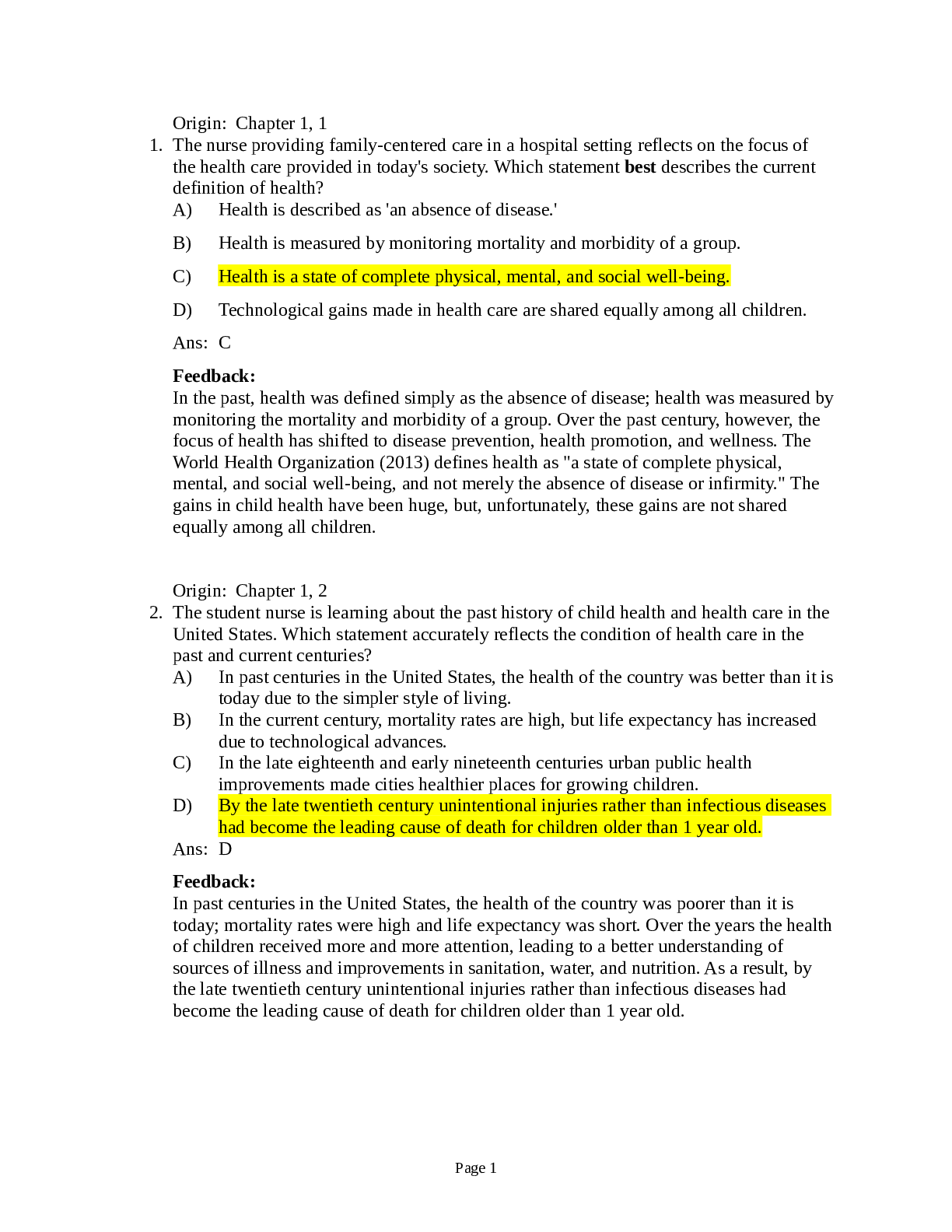
Reviews( 0 )
Document information
Connected school, study & course
About the document
Uploaded On
Jun 11, 2021
Number of pages
32
Written in
Additional information
This document has been written for:
Uploaded
Jun 11, 2021
Downloads
0
Views
57

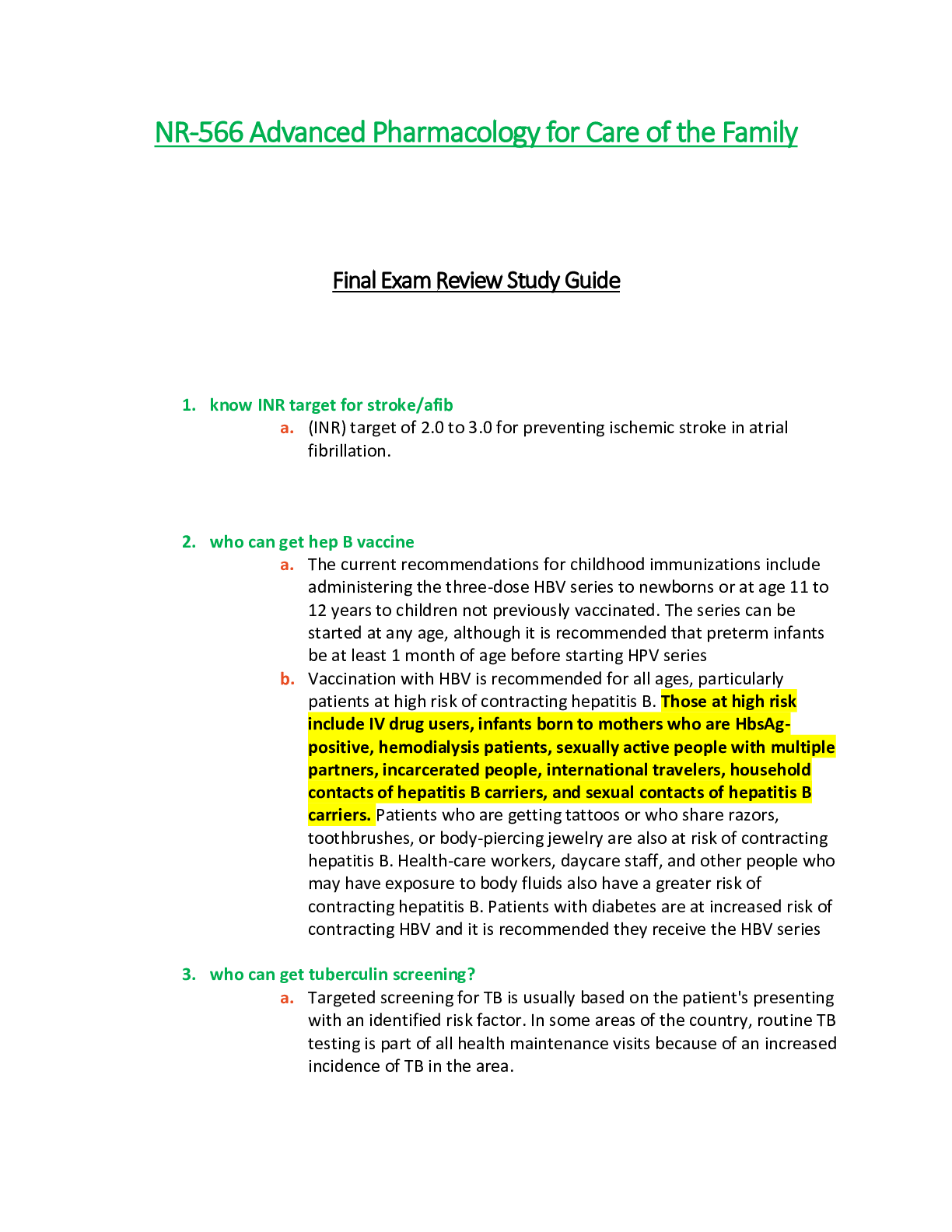
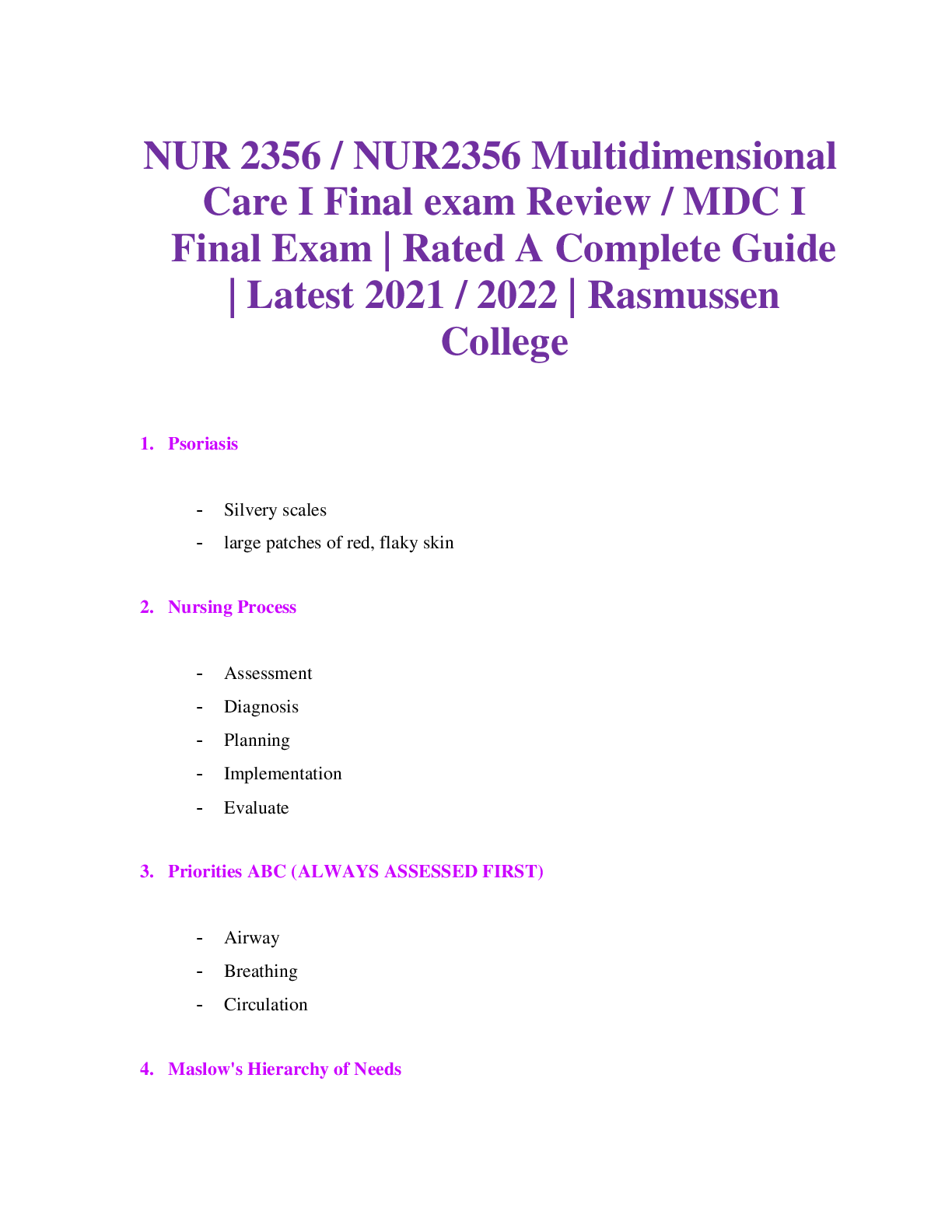
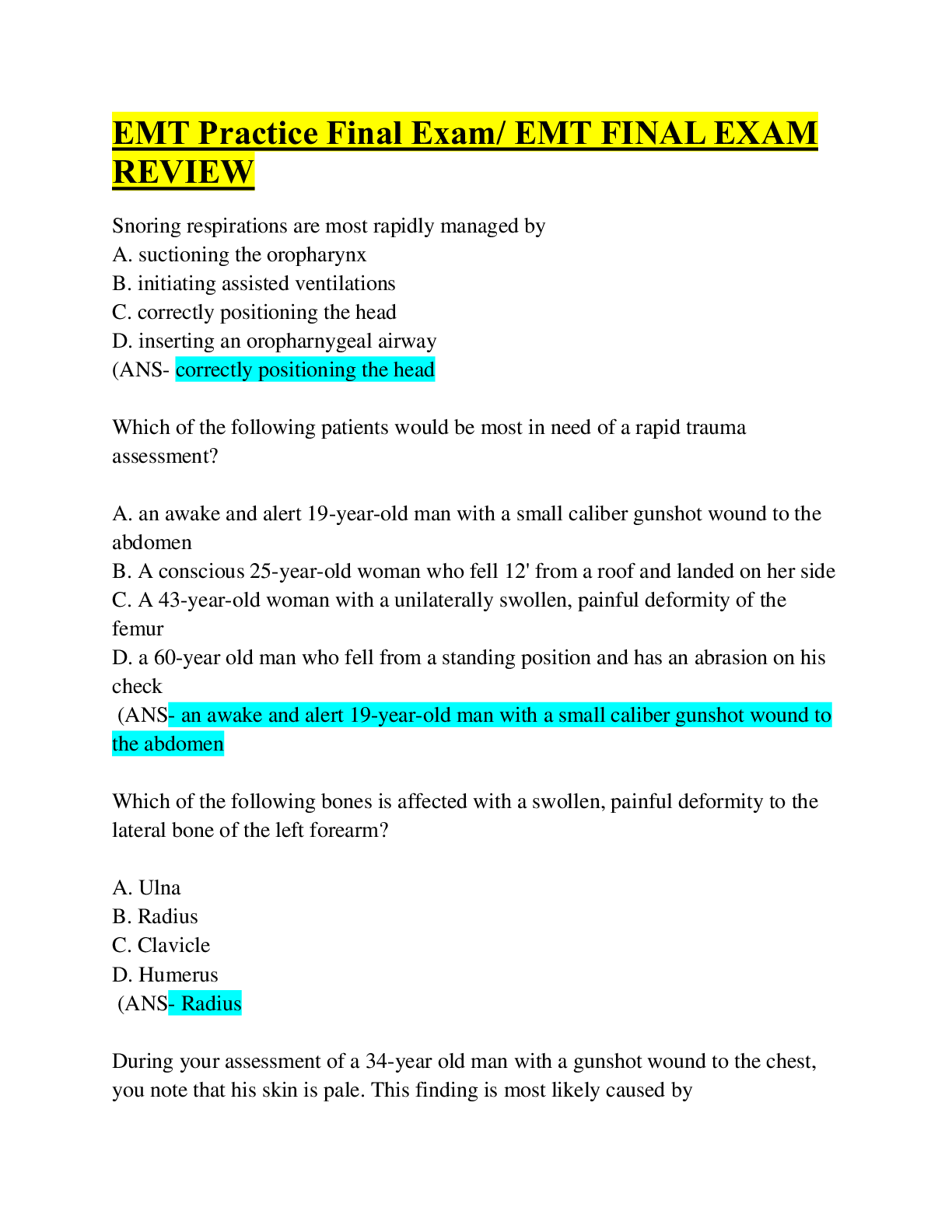

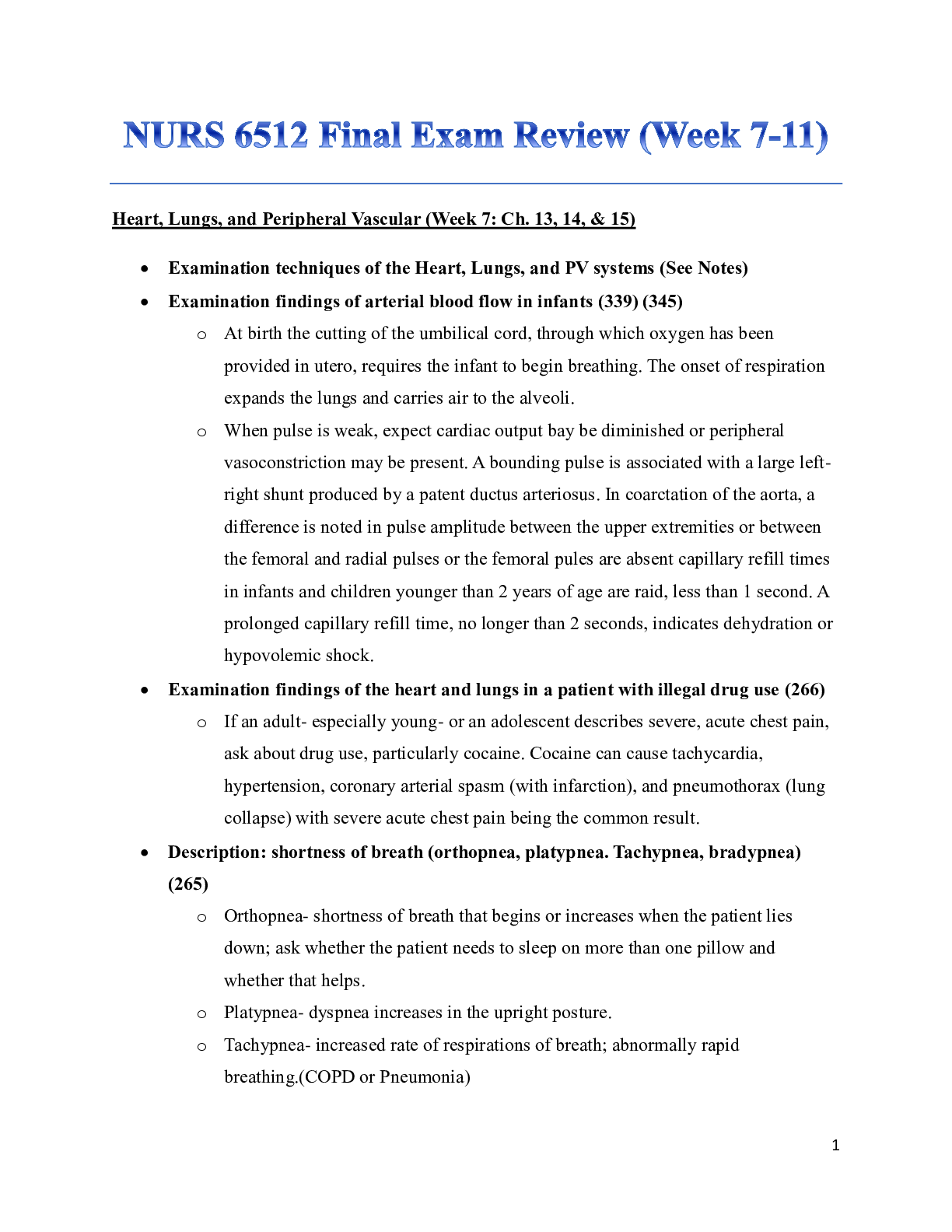
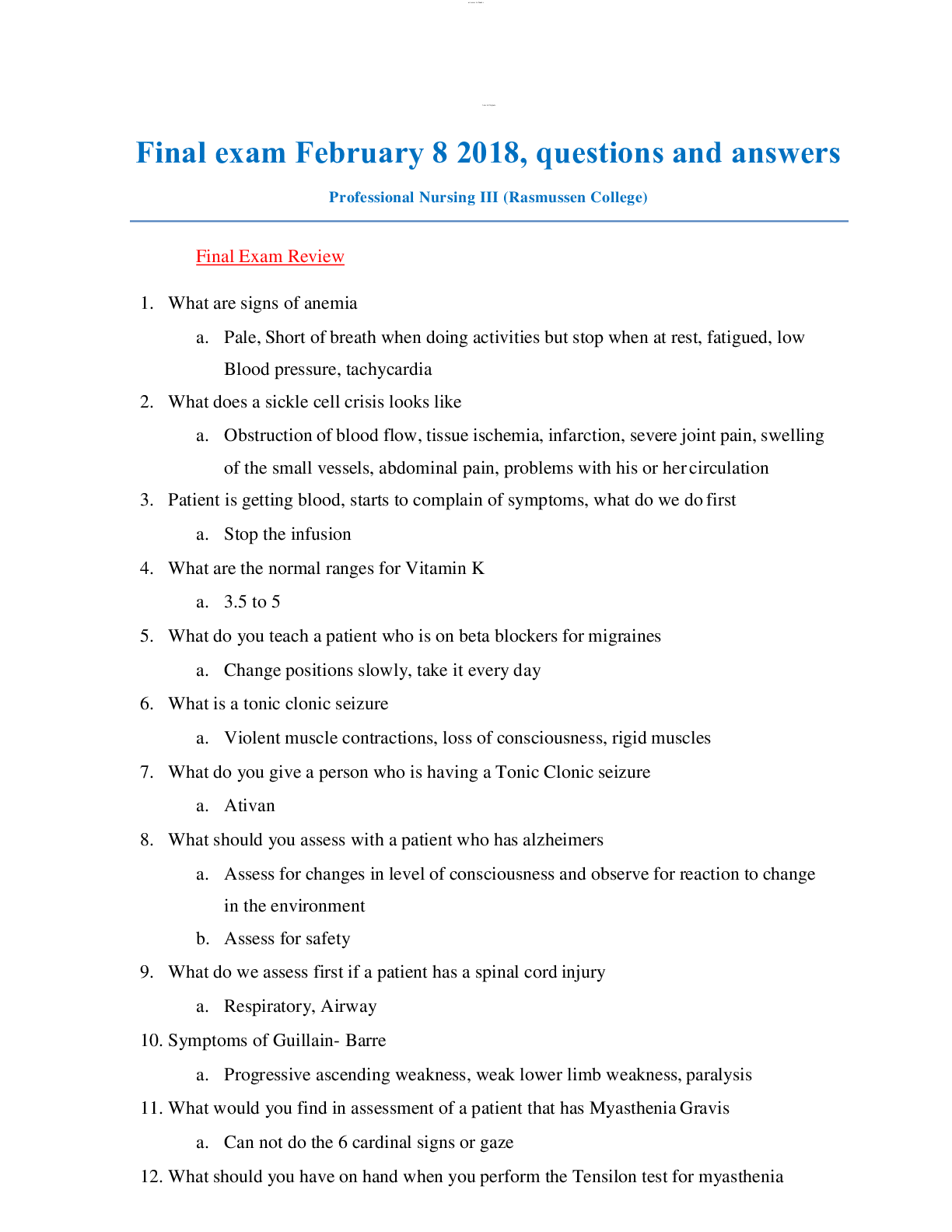
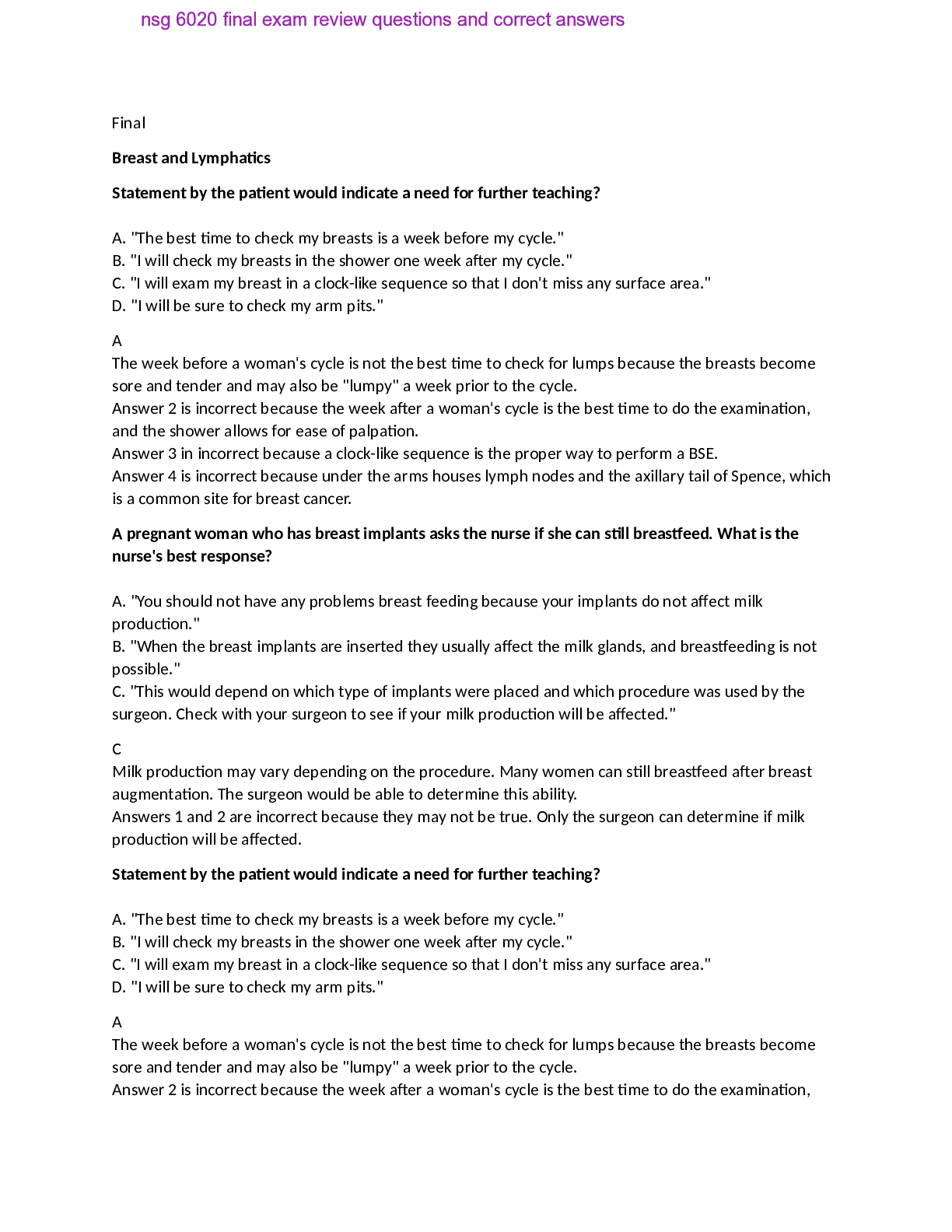
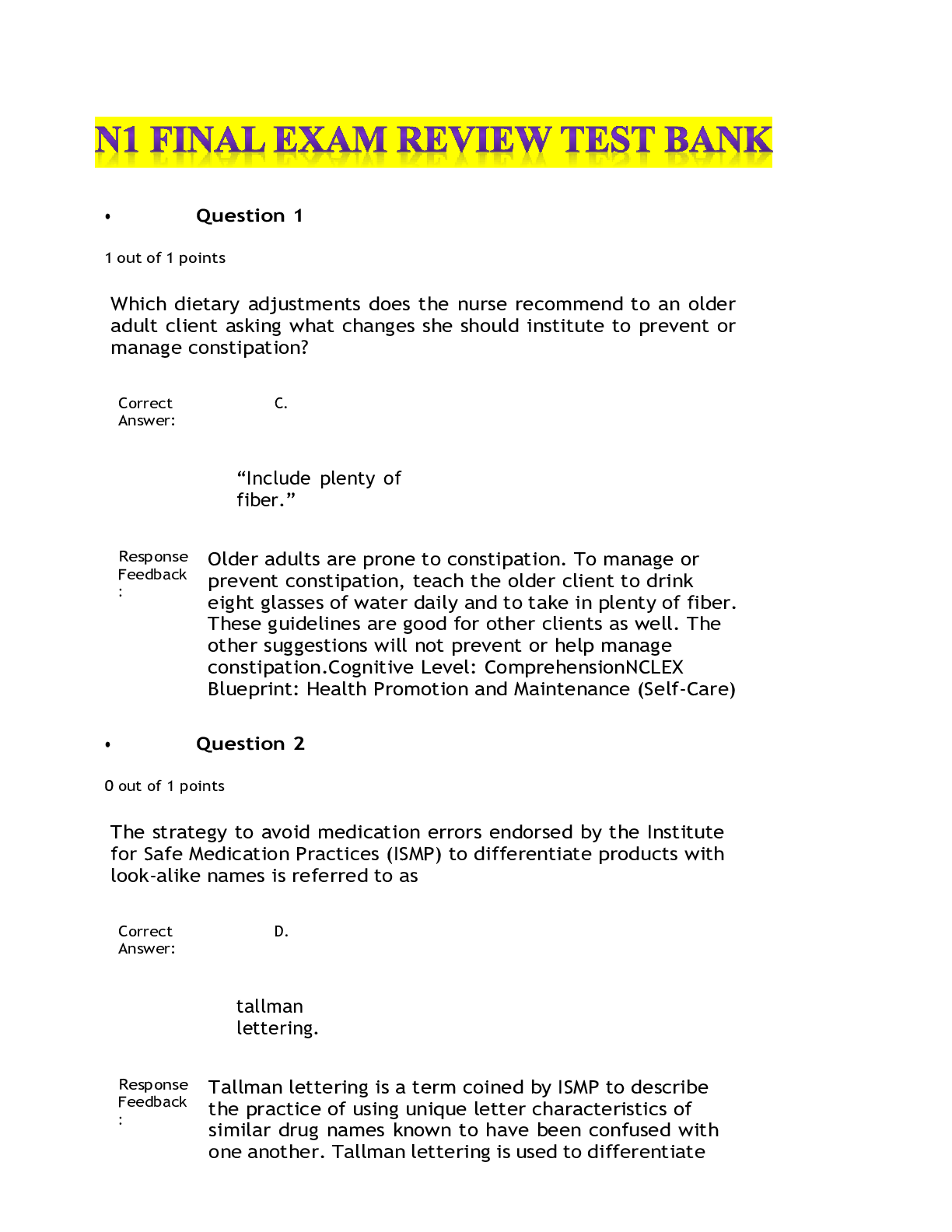
.png)
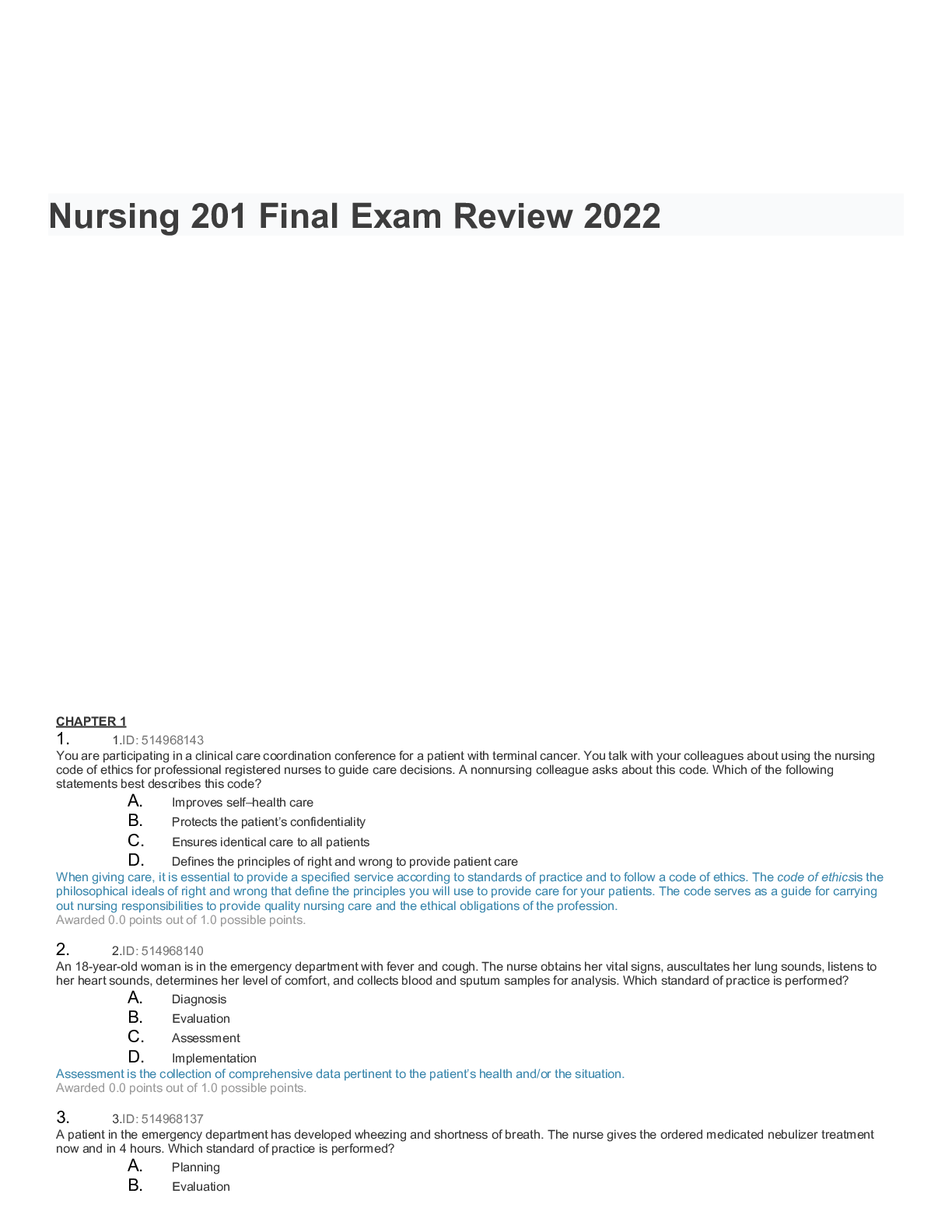
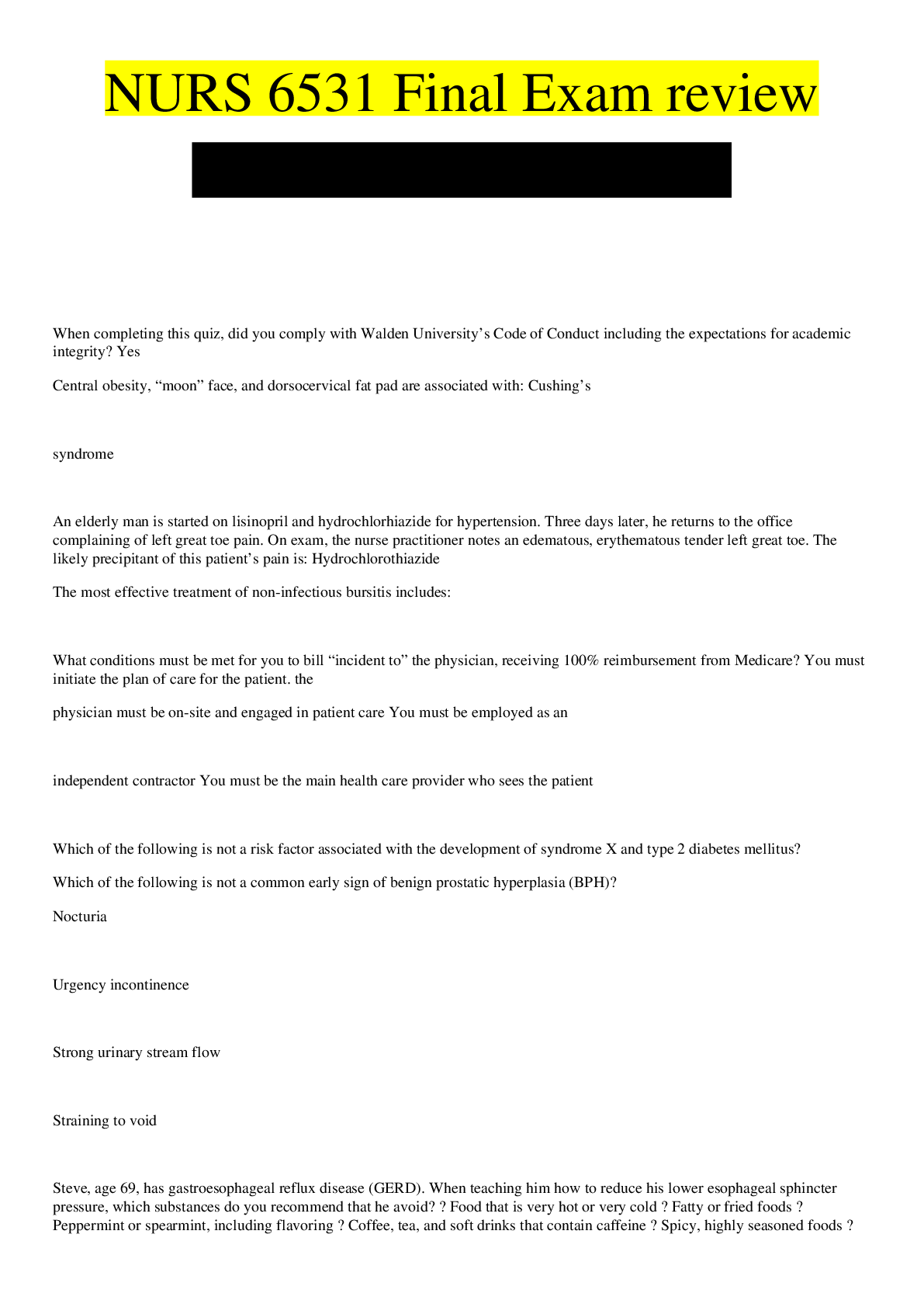

 (1).png)
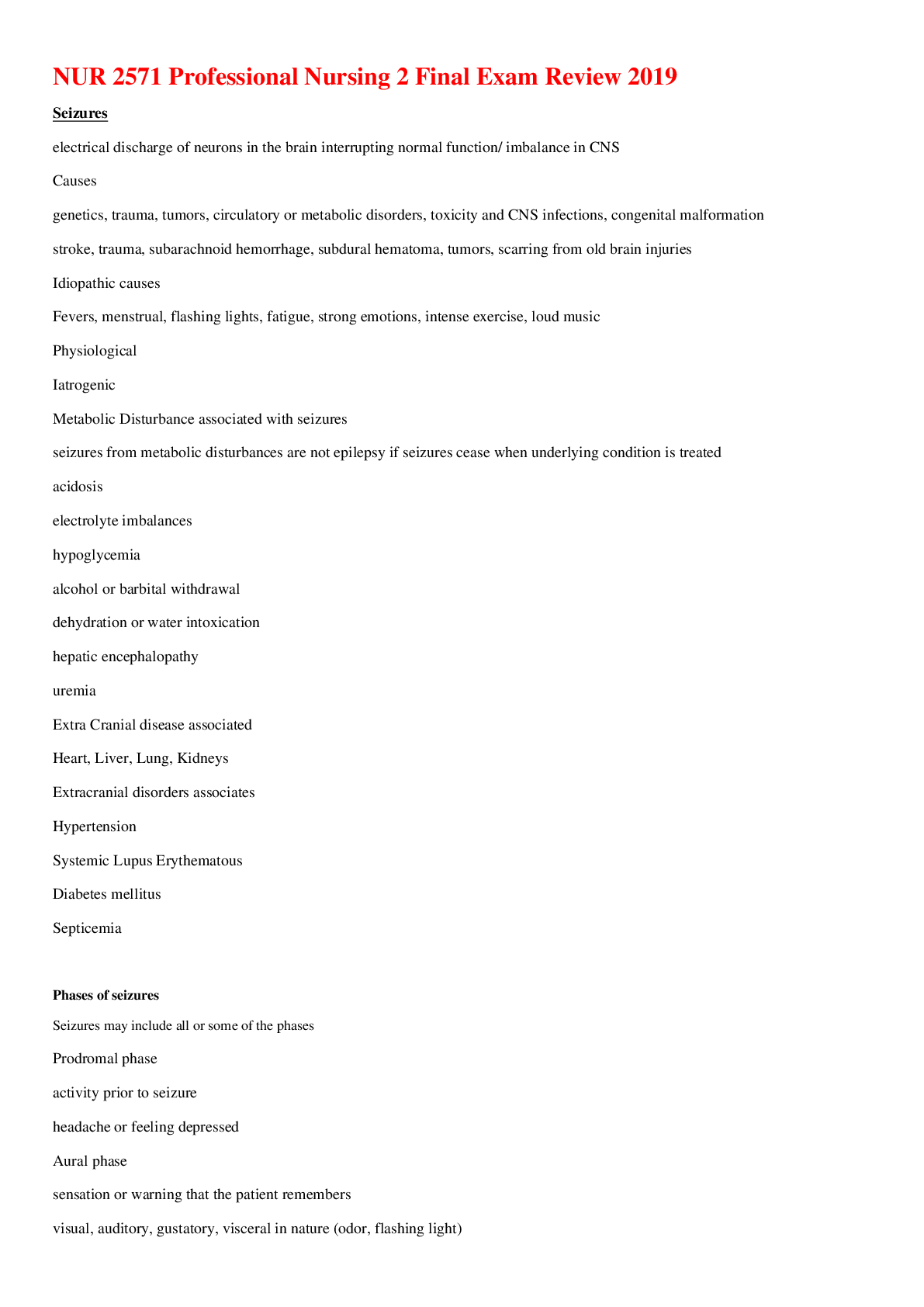
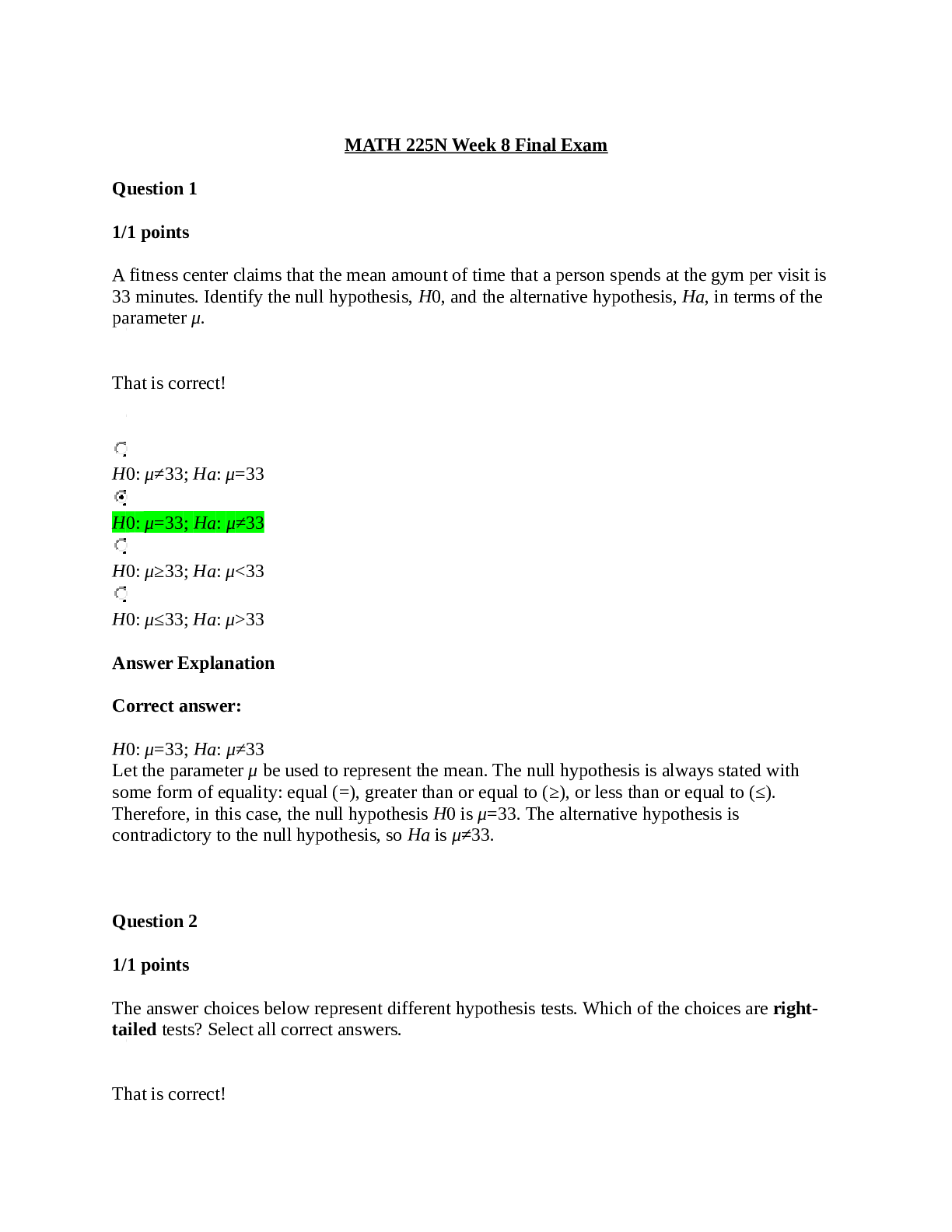

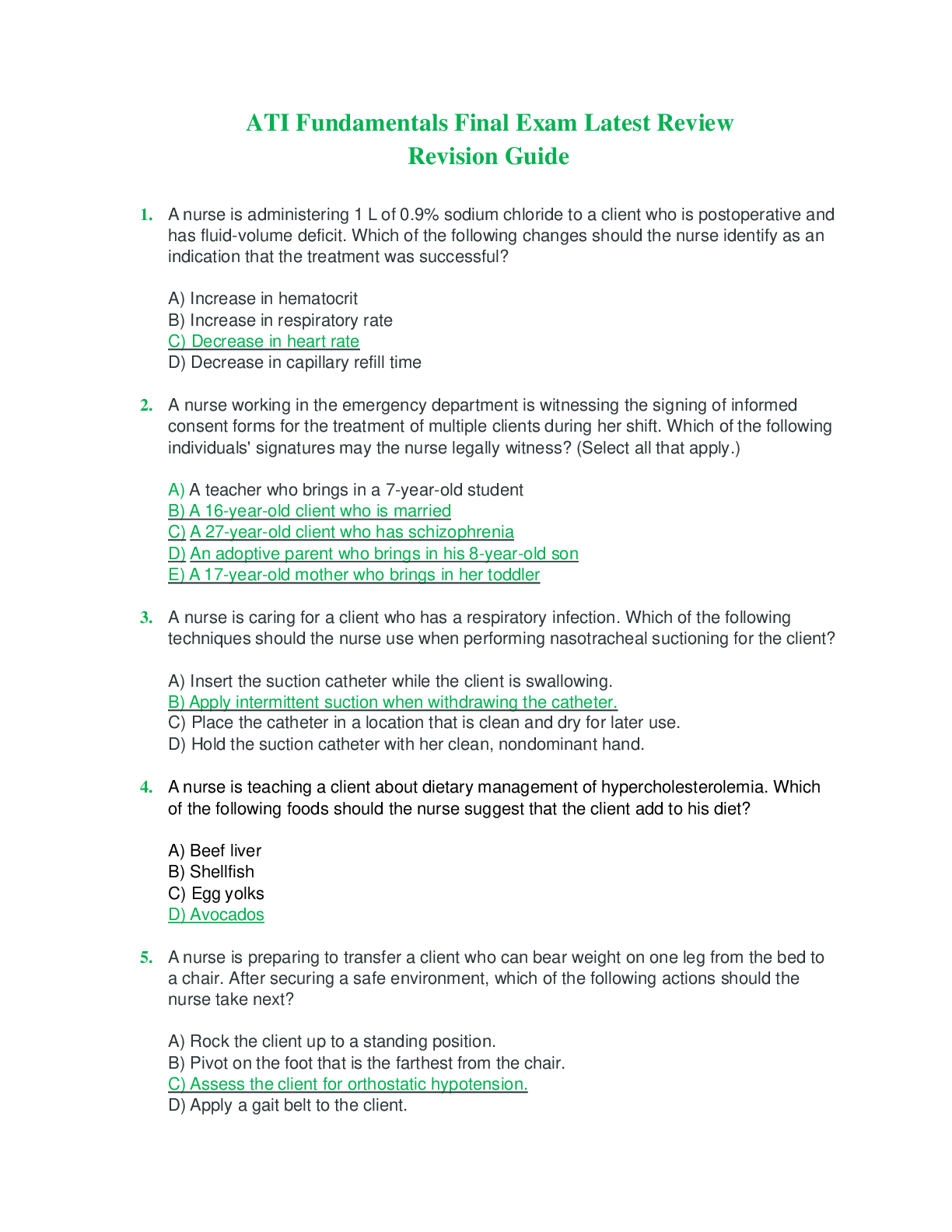
.png)
 (1).png)
 (1).png)

